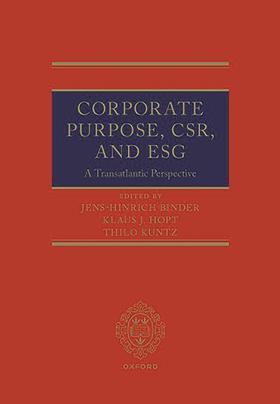Corporate Purpose, CSR, and ESG
Edited by Jens-Hinrich Binder, Klaus J. Hopt and Thilo Kuntz
£145, Oxford University Press
★★★★✩
Binder, Hopt and Kuntz provide a detailed examination of the evolving concepts of corporate purpose, corporate social responsibility (CSR), and environmental, social and governance (ESG) issues. This is timely, given the breakneck speed of developments in both Europe and the United States, albeit seemingly divergent in approach and appetite.
The editors bring together scholars from the US, Germany, France and the UK (among others) to explore these concepts within their respective geographical settings. This highlights the diversity of thinking in relation to these ideas and the theoretical foundations that underpin them. Yet, such a wide-ranging discussion also underscores a common criticism of ESG: that its broadness renders it nebulous and difficult to operationalise.

One of the key themes explored is the contrast between the European regulatory approach and the US shareholder/finance-driven model. The European approach, exemplified by regulations such as the Sustainable Finance Disclosure Regulation and the Corporate Sustainability Reporting Directive, emphasises transparency and accountability via corporate reporting. In contrast, the US is focused on shareholder value and financial performance, leading to a public debate about the financial opportunities in green technologies versus the cost of ESG initiatives (and accusations of ‘wokeness’).
The perceived link between ESG and finance also stands in contrast to notions of corporate purpose and CSR, which appear to be driven by ideological positions in an ongoing debate about whether the corporation should be run for its shareholders or its stakeholders. An interesting viewpoint of Esser and MacNeil (Chapter 7) is that rather than attempting to create environmental and social change via the pressures of enhanced financial disclosures and narrative reporting, as ESG regulation has developed to do, we should echo the approach formerly taken to CSR, focusing on the activity of the individual corporate entity. It is the link between the corporation and its impact on the environment and its social context that is important and, once that link is expressed, capital will follow. This would put director decision-making under greater scrutiny – in my view, a good thing – providing the freedom for bold choices while reducing management time reacting to reporting requirements.
Overall, the work offers valuable insights into the rapidly evolving landscape of corporate responsibility and sustainability. By examining these concepts from multiple angles and across different regions, the book provides a nuanced summary of the challenges faced and opportunities for change. However, a common approach seems further away than ever.
Tom Proverbs-Garbett is a consultant





























No comments yet